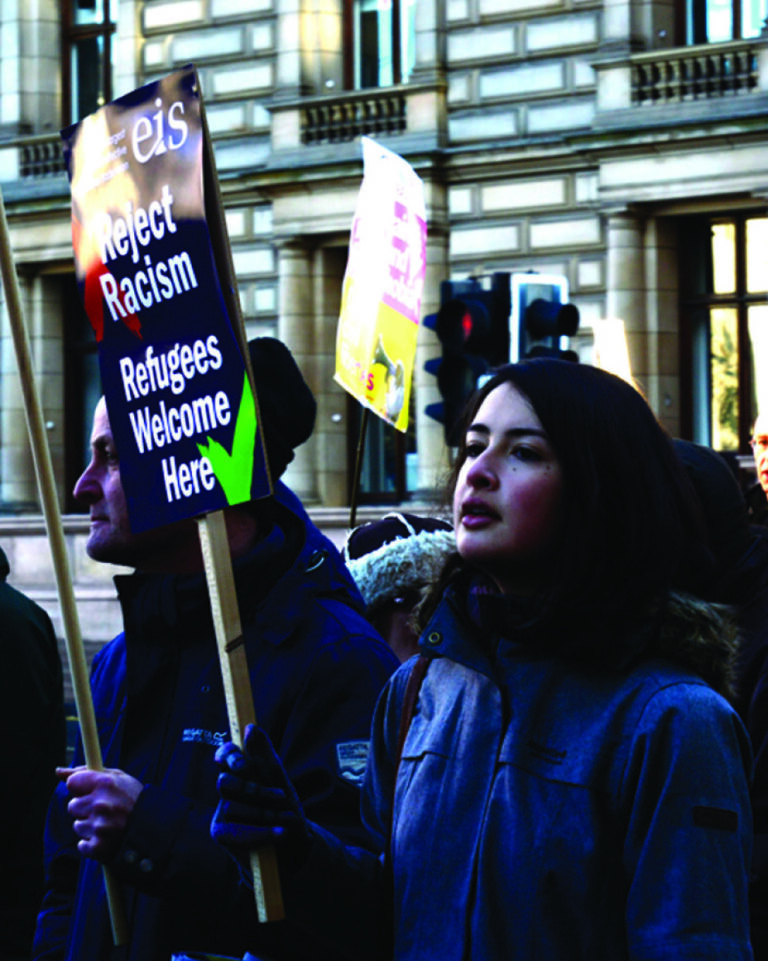Back in the early 1990s, the support available for teachers of colour was very limited. The EIS did not yet have a network for black or minority ethnic members. However, it recognised its own shortcomings, and was keen to provide a voice to teachers of colour.
For teachers such as Rowena Arshad, at the time a lecturer at a college of higher education, this was extremely welcome. “I realised, as a young woman of colour, that I wasn’t getting very much recognition at my college of education,” says Arshad. “There weren’t any networks or allies.”
Arshad joined the EIS’s embryonic race-equality committee, known at the time as the multicultural subcommittee. Though the members of this committee were predominantly white, they were nonetheless aware of the importance of delivering proactive antiracist education across Scotland.
The word “antiracism” tended to alarm people at the time; “multicultural” was often preferred. The EIS, though, was not so easily alarmed: instead, it was at the vanguard of the shift to a more direct, honest language. A year or two after Arshad joined, its multicultural committee added the word “antiracist” to its name.
“The EIS dared to use terminology that was unpalatable at the time,” says Arshad. “It named issues, rather than using fluffy terms like ‘inclusion’ and ‘diversity’. It wasn’t afraid to name and shame.”
Though Arshad – and another occasional member – were the only people of colour on the committee, the EIS recognised the importance of lived experience in naming and combatting racism.
And the existence of its multicultural subcommittee legitimised racism in education as a topic of conversation. It provided teachers with a place where they could develop their antiracist politics, and with a network of people to encourage them in this.
The EIS also allowed members access to experienced trade unionists who could advise them on the correct course of action to take, should they witness any racial discrimination in the workplace.
For example, if black or minority-ethnic student teachers experienced discrimination during their work placements, they tended to be told by their college simply to put up with it: finding a placement was difficult, so they were better off just sticking with the one they had.
In those early days, the STUC didn’t offer any meetings for black workers. So, in 1993, the EIS agreed to finance an annual trip by antiracist committee members to attend the TUC’s conference for black workers in England.
EIS members subsequently went to the STUC executive and asked why it was necessary to travel to England in order to discuss their needs and rights. The STUC had no answer for this, and so, in 1995, its first conference for black and minority ethnic members was held. In 1996, it was established as an annual event, and it still continues today.
“The EIS was at the cutting edge,” says Arshad. “It was one of only a few unions at that point that was prepared to champion its minority members, that didn’t shy away from its obligation to do so, and that was prepared to invest in black members.
“We helped shape the landscape in Scotland on race: breaking glass ceilings and moving up from sticky floors. And we’re still pushing boundaries now: getting the union to think about whiteness and decolonising the curriculum.”
In fact, the EIS antiracist subcommittee – the “multicultural” part of its name having fallen by the wayside as times and terminology changed – is still helping to set the agenda of the debate in Scotland.
“There was a feeling in schools, and in education more widely, that antiracism shouldn’t be addressed explicitly, but should be subsumed into the broader curriculum,” says Asif Chishti, current chair of the antiracist subcommittee. “So, a lot of our work at the time was campaigning for discrete antiracism education.”
Even in the 21st century there’s an inclination among liberal teachers to deny the difference of race: to insist on a version of, “We’re the same race – we’re all Scottish.” But race exists, and it is denying someone’s lived reality to say that it doesn’t.
In the mid-2010s, with anti-immigration rhetoric and Islamophobia both spreading, there remained nonetheless a lingering fear of tackling racism directly in schools. So, the EIS published a book entitled Myths of Immigration. The aim was to tackle myths arising around deliberately constructed, hostile stereotypes and slogans, which were increasingly becoming part of common parlance.
A number of teachers had reported to the EIS that they wanted to tackle these stereotypes. But, in many cases, they lacked the knowledge, tools and support to be able to challenge anti-immigration attitudes.
“We could sit back and think, that’s not our job to do that as a union,” says Chishti. “But we’re talking about the furtherance of education. I just think it’s a really important part of who we are, of our identity as an institute. We have expertise in our union. Let’s channel that expertise into something that’s right.”

Nonetheless, the situation remains far from ideal. An EIS survey of black and minority ethnic teachers, conducted in 2018, found that 71 per cent of all respondents had experienced racism in their capacity as a teacher. Nearly a third – 30 per cent – of respondents from Asian backgrounds had heard colleagues use racist or Islamophobic language.
And so, since 2020, the antiracist subcommittee has focused on setting up a national black and minority ethnic (BAME) network for members across Scotland. And it has worked to provide professional training and support to teachers who want to model antiracism in the classroom, regardless of their own ethnic background.
“I’m very much of the opinion that it shouldn’t have to be BAME teachers taking forward antiracism in Scottish education,” says Chishti. There are not enough BAME teachers in Scotland for that. What are we meant to do, wait for the cavalry to arrive? “But I think our colleagues are totally willing to get involved. It’s just about giving them the right tools to do that.”
To counteract hostility towards refugees, immigrants and asylum seekers, the renowned Refugee Welcome Packs are distributed annually to newly arrived children and families across Scotland. The EIS has also created a colourful teaching resource on the Glasgow Girls activists of the early 2000s, who campaigned to end the detention of asylum-seeker children.
Over the past couple of years, the Institute has extended its antiracism strategy further, to co-designing and delivering a series of learning activities on challenging racism in educational establishments, creating an online resource to give some extra support in this area.
Many challenges remain on the road to race equality. But EIS members know that a growing cadre of equality reps is here to help them face these challenges – and overcome them
ACKNOWLEDGEMENTS:
Research, interviews and substantive writing:
Adi Bloom
Design and lay-out:
Stuart Cunningham and Paul Benzie
Additional writing and research:
EIS Comms Team and assorted staff members
Printed by:
Ivanhoe Caledonian, Seafield Edinburgh
Photography:
Graham Edwards, Mark Jackson, Elaine Livingston, Toby Long, Ian Marshall, Alan McCredie, Alan Richardson, Graham Riddell, Lenny Smith, Johnstone Syer, Alan Wylie


Thanks to the many former activists and officers who gave of their time to be interviewed and taken a stroll down memory lane. And of course a very special thanks to the EIS members who created this history through their activism and commitment to the cause of Scottish Education.
© 2022 The Educational Institute of Scotland